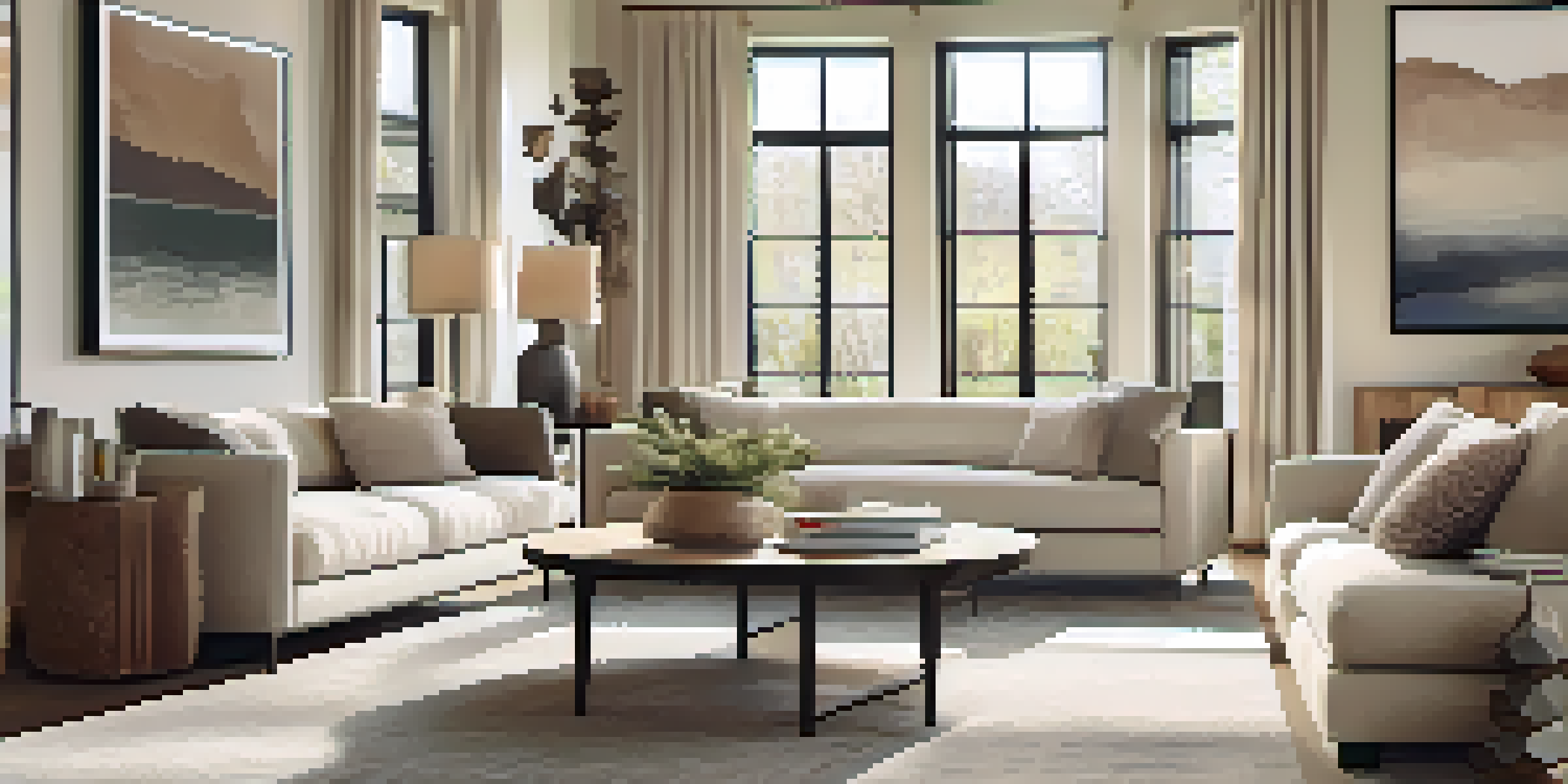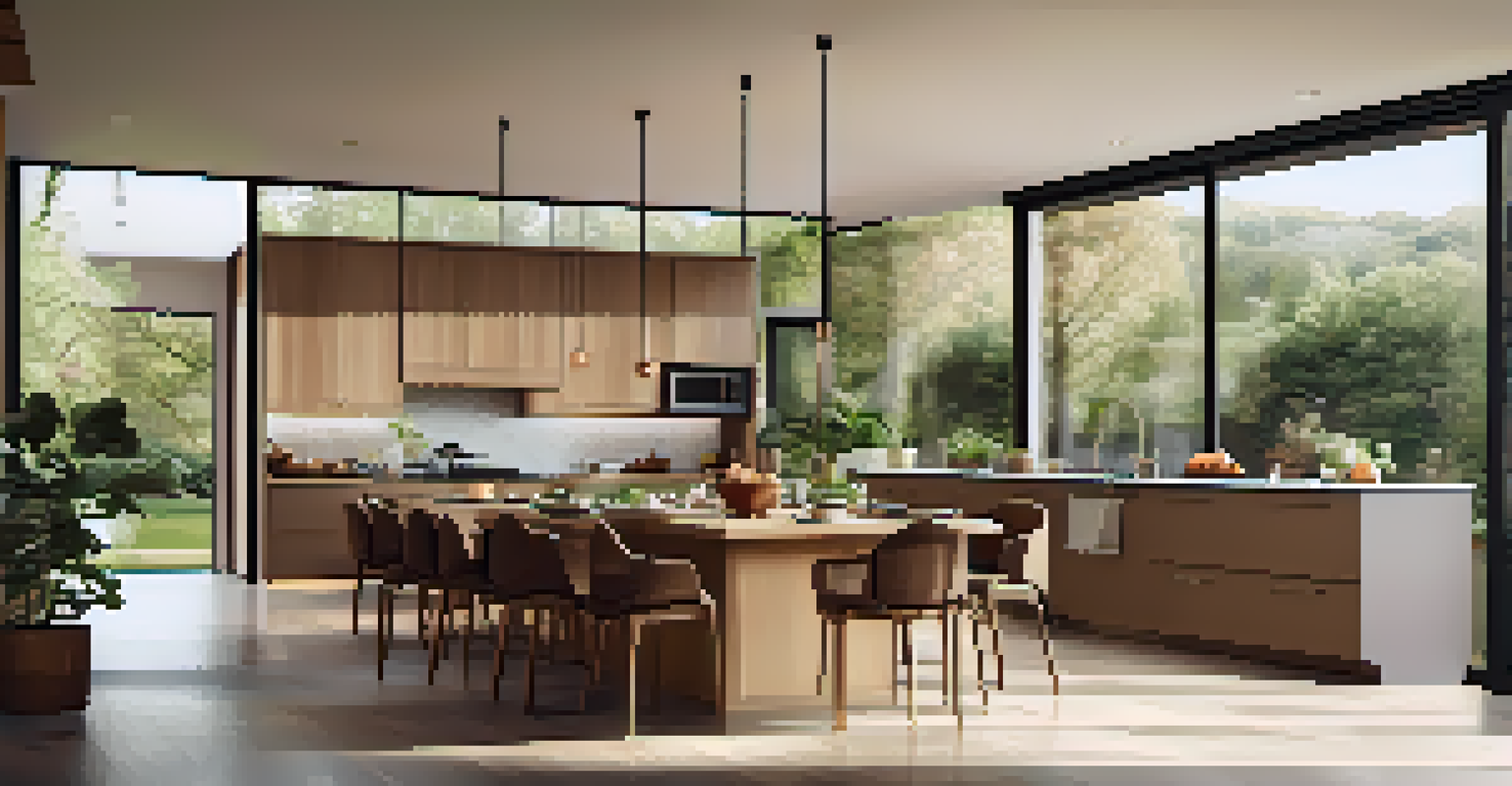Creating Flow: How to Stage Your Home for a Natural Layout

Understanding the Concept of Flow in Your Home
Flow in home design refers to the way spaces connect and interact, creating a seamless experience. Think of it as the natural movement you feel when walking through a well-designed space. It’s about ensuring that each room invites you into the next, much like a gentle stream leading you through a lush garden.
The details are not the details. They make the design.
When your home has good flow, it feels inviting and comfortable, allowing you to move freely without feeling cramped or disoriented. A well-staged home should tell a story, guiding guests through your space as if they are on a delightful journey. By understanding flow, you can better appreciate how layout affects not just aesthetics, but also functionality.
To achieve this, consider how each area relates to the others. Are there clear sightlines? Does the layout encourage movement? By paying attention to these details, you can create an environment that feels harmonious and inviting, setting the stage for a perfect flow.
Decluttering: The First Step to a Natural Layout
Before you can create a natural flow, it’s essential to declutter your space. This means removing items that don’t belong or that you simply don’t need. Picture a river obstructed by fallen branches; the water can’t flow freely. Similarly, clutter can disrupt the flow of your home.

Start by evaluating each room and asking yourself what you truly use and love. If an item doesn’t serve a purpose or bring you joy, consider letting it go. This process not only creates more physical space but also promotes a sense of mental clarity, allowing you to focus on the layout and flow of your home.
Flow Enhances Home Experience
Good flow in home design creates a seamless transition between spaces, making the home inviting and comfortable.
Once decluttering is complete, you’ll be surprised at how much larger and more inviting your rooms feel. With a clean slate, you can now think about how to arrange furniture and decor to enhance flow and create a welcoming atmosphere.
Choosing the Right Furniture for Optimal Flow
Selecting the right furniture is crucial for promoting flow in your home. Consider pieces that are functional yet aesthetically pleasing, allowing you to maintain an open atmosphere. Large, bulky items can crowd a space, while sleek designs encourage movement and interaction.
Design is not just what it looks like and feels like. Design is how it works.
Think about scale and proportion; furniture that is too large can overwhelm a room, while too-small pieces can get lost in the space. A good rule of thumb is to leave enough room to walk comfortably around furniture without feeling cramped. For example, aim for at least 2-3 feet of space between larger items to maintain that inviting flow.
Additionally, consider multi-functional furniture, such as ottomans that double as storage. This not only saves space but also keeps the room looking tidy, enhancing the overall flow and functionality of your living area.
Creating Clear Pathways for Easy Movement
Clear pathways are essential for a naturally flowing layout. Imagine walking through a forest; you want to feel guided by clear trails rather than navigating through thick underbrush. In your home, pathways should be wide enough to allow for easy movement without obstruction.
When arranging furniture, consider the natural flow of foot traffic. Place larger items away from high-traffic areas and create clear lines of sight from one room to another. This not only makes the space more functional but also visually appealing, as guests can easily navigate your home.
Declutter for Better Layout
Removing unnecessary items allows for a clearer layout and promotes a natural flow throughout your home.
Don’t forget to include transitional spaces, like hallways and entryways, in your planning. These areas should be well-lit and inviting, ensuring that the flow continues from one space to the next, creating a cohesive experience throughout your home.
Using Color to Enhance Flow and Connection
Color plays a significant role in creating flow and connection within your home. It can evoke emotions, create ambiance, and visually link different spaces. For instance, using a cohesive color palette throughout your home can tie rooms together, making them feel like part of a larger whole.
Consider painting adjacent rooms in complementary shades to foster a sense of unity. Soft, neutral tones can create a calming effect, while bolder colors can add energy and vibrancy to your layout. Just like a beautifully composed painting, the right colors can enhance the overall flow of your home.
Additionally, you can use accessories, such as cushions or artwork, to echo your chosen color scheme. This reinforces the connection between spaces, drawing the eye and encouraging movement throughout your home. Remember, the goal is to create an inviting atmosphere that feels harmonious and balanced.
Incorporating Lighting to Improve Flow
Lighting is often an overlooked aspect of creating flow, yet it can dramatically influence how spaces are perceived. Good lighting can highlight key areas and create a sense of warmth, making your home feel more inviting. Imagine walking into a room bathed in natural light versus one that feels dark and unwelcoming; the difference is striking.
To enhance flow, consider layering your lighting. Use a combination of ambient, task, and accent lighting to create a well-lit environment. For example, overhead lights can provide general illumination, while table lamps can create cozy reading nooks, inviting people to linger.
Lighting and Color Connect Spaces
Using cohesive colors and effective lighting can enhance the connection between rooms, contributing to an overall harmonious atmosphere.
Don’t forget about natural light, either! Position furniture to maximize sunlight during the day, and use sheer curtains to let light filter through while maintaining privacy. A bright, well-lit space encourages movement and interaction, enhancing the overall flow of your home.
Adding Personal Touches to Create a Welcoming Atmosphere
Finally, adding personal touches can create an inviting atmosphere that enhances flow in your home. Think of your favorite photos, artwork, or heirlooms that tell your story. These elements not only add character but also make guests feel at home, encouraging them to explore and connect with your space.
When incorporating personal items, be mindful of placement. Arrange them in a way that complements your layout and doesn’t obstruct pathways. For instance, a well-placed family photo can draw the eye and create a focal point without interrupting the flow of movement through the room.

Remember, the goal is to create an environment that reflects your personality while maintaining a sense of cohesion. By thoughtfully integrating personal touches, you can create a space that feels both inviting and harmonious, truly embodying the concept of flow.